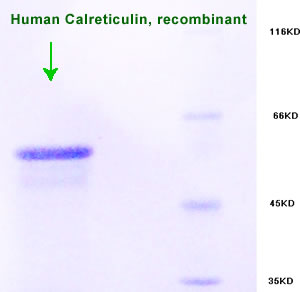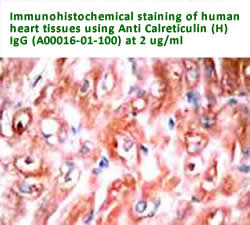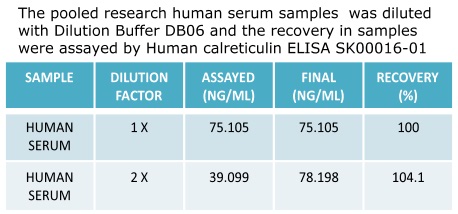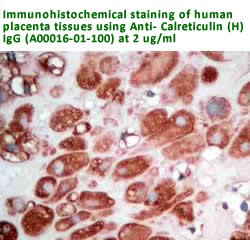| |
| Calreticulin (CRT) ELISA Kit, Recombinant & Antibody |
| Extracellular calreticulin is present in the joints of rheumatoid arthritis patients and inhibits FasL (CD95L) mediated apoptosis of T cells |
- OBJECTIVE.: The binding of FasL (CD95L) to its receptor Fas (CD95) induces apoptosis. Studies have shown that in rheumatoid arthritis (RA) patients, T lymphocytes are resistant to FasL-induced apoptosis in vivo, but susceptible to FasL-induced apoptosis in vitro. Dysfunction in this mechanism may be an important contributor to the pathophysiology of RA. Thus, we sought to determine which factors might inhibit FasL-Fas binding in vivo and inhibit apoptosis of T lymphocytes in an in vitro model system. METHODS.: Human jurkat T cells rendered apoptotic by FasL exposure were analyzed by flow cytometry. Necrosis was measured by lactate dehydrogenase (LDH) release. Quantification of calreticulin (CRT) in plasma and synovial fluids and CRT-FasL binding were performed by ELISA. Measurement of nitrite/nitrate in plasma and synovial fluid was carried out by chemiluminescence. RESULTS.: Extracellular CRT was present at a significantly higher concentration (P<0.05) in the plasma (mean, IQR - 10.3, 14.8 ng/ml) and synovial fluid (10.3, 12.0 ng/ml) of RA patients compared with psoriatic arthritis synovial fluid (3.1, 1.3 ng/ml) or healthy control plasma (2.9, 0.9 ng/ml). Plasma and synovial fluid CRT concentrations correlated with tender and swollen joint counts and DAS28 activity scores. CRT also bound directly to FasL. CRT (2-16 ng/ml) inhibited FasL induced apoptosis of Jurkat T cells in vitro. CONCLUSION.: CRT was present at higher concentrations in the plasma and synovial fluid of RA patients. CRT had the capacity to bind directly to FasL, and inhibiting FasL- mediated apoptosis of Jurkat T cells, and might play a role in inhibiting apoptosis of inflammatory T cells in RA.Tarr JM, Arthritis Rheum. 2010 Jun 8. [Epub ahead of print]
|
| Calreticulin: non-endoplasmic reticulum functions in physiology and disease |
-
- Calreticulin (CRT), when localized to the endoplasmic reticulum (ER), has important functions in directing proper conformation of proteins and glycoproteins, as well as in homeostatic control of cytosolic and ER calcium levels. There is also steadily accumulating evidence for diverse roles for CRT localized outside the ER, including data suggesting important roles for CRT localized to the outer cell surface of a variety of cell types, in the cytosol, and in the extracellular matrix (ECM). Furthermore, the addition of exogenous CRT rescues numerous CRT-driven functions, such as adhesion, migration, phagocytosis, and immunoregulatory functions of CRT-null cells. Recent studies show that topically applied CRT has diverse and profound biological effects that enhance cutaneous wound healing in animal models. This evidence for extracellular bioactivities of CRT has provided new insights into this classically ER-resident protein, despite a lack of knowledge of how CRT exits from the ER to the cell surface or how it is released into the extracellular milieu. Nonetheless, it has become clear that CRT is a multicompartmental protein that regulates a wide array of cellular responses important in physiological and pathological processes, such as wound healing, the immune response, fibrosis, and cancer. Gold LI, et al. FASEB J. 2010 Mar;24(3):665-83. Epub 2009 Nov 25.
-
|
| A Mechanism of Release of Calreticulin from Cells During Apoptosis. |
- Calreticulin (CRT) is an endoplasmic reticulum (ER) chaperone responsible for glycoprotein folding and Ca(2+) homeostasis. CRT also has extracellular functions, e.g. tumor and apoptotic cell recognition and wound healing, but the mechanism of CRT extracellular release is unknown. Cytosolic localization of CRT is determined by signal peptide and subsequent retrotranslocation of CRT into the cytoplasm. Here, we show that under apoptotic stress conditions, the cytosolic concentration of CRT increases and associates with phosphatidylserine (PS) in a Ca(2)(+)-dependent manner. PS distribution is regulated by aminophospholipid translocase (APLT), which maintains PS on the cytosolic side of the cell membrane. APLT is sensitive to redox modifications of its SH groups by reactive nitrogen species. During apoptosis, both CRT expression and the concentration of nitric oxide (NO) increase. By using S-nitroso-l-cysteine-ethyl-ester, an intracellular NO donor and inhibitor of APLT, we showed that PS and CRT externalization occurred together in an S-nitrosothiol-dependent and caspase-independent manner. Furthermore, the CRT and PS are relocated as punctate clusters on the cell surface. Thus, CRT induced nitrosylation and its externalization with PS could explain how CRT acts as a bridging molecule during apoptotic cell clearance. Tarr JM, et al. J Mol Biol. 2010 Sep 3;401(5):799-812. Epub 2010 Jul 17.
|
| The differential expression of aqueous soluble proteins in breast normal and cancerous tissues in relation to ethnicity of the patients; Chinese, Malay and Indian |
- Female breast cancer is one of the leading causes of female mortality worldwide. In Malaysia, breast cancer is the most commonly diagnosed cancer in women. Of the women in Malaysia, the Chinese have the highest number of breast cancer cases, followed by the Indian and the Malay. The most common type of breast cancer is infiltrating ductal carcinoma (IDC). A proteomic approach was applied in this study to identify changes in the protein profile of cancerous tissues compared with normal tissues from 18 patients; 8 Chinese, 6 Malay and 4 Indian were analysed. Twenty-four differentially expressed hydrophilic proteins were identified. We evaluated the potential of these proteins as biomarkers for infiltrating ductal carcinoma based on their ethnic-specific expressions. Three of the upregulated proteins, calreticulin, 14-3-3 protein zeta and 14-3-3 protein eta, were found to be expressed at a significantly higher level in the cancerous breast tissues when compared with the normal tissues in cases of infiltrating ductal carcinoma. The upregulation in expression was particularly dominant in the Malay cohort. Liang S, et al. Dis Markers. 2010;28(3):149-65.
|
 |
 |
|
|
Code No.:SK 00016-01
Size: 96 T
Price: $420.00 USD
Standard range: 3.9 -500 ng/ml
Sensitivity: 50-100 pg/ml
Sample type: serum, plasma, cell cultures
Intra-CV: 6-8%
Inter-CV: 8-10%
Data Sheet: PDF
|

|
Code No.: 00016-01-100
Size: 100 ug
Price: $360.00 USD
Protein ID:P27797
Gene ID: 511
MW: 50 KD
Tag: His Tag on N-Terminus
Expressed: E. Coli
Purity: 90%
Data Sheet: PDF
|

|
Code No.: A00016-01-100
Size: 100 ug
Price: $220.00 USD
Host: Rabbit
Antigen: human calreticulin Rec.
Ab Type: Polyclonal IgG
Purification: Protein A
Applications: E, IHC, WB
Working Dilution: IHC 1: 500 (2 ug/ml)
Data Sheet: PDF |
|
|
Code No.: A00016-01-100
Size: 100 ug
Price: $220.00 USD
Host: Rabbit
Antigen: human calreticulin Rec.
Ab Type: Polyclonal IgG
Purification: Protein A
Applications: E, IHC, WB
Working Dilution: IHC 1: 500 (2 ug/ml)
Data Sheet: PDF |
|
Code No.: A00016-01-100
Size: 100 ug
Price: $220.00 USD
Host: Rabbit
Antigen: human calreticulin Rec.
Ab Type: Polyclonal IgG
Purification: Protein A
Applications: E, IHC, WB
Working Dilution: IHC 1: 500 (2 ug/ml)
Data Sheet: PDF |
| |
|
| Name |
Code No. |
Size |
Price ($) |
| Calreticulin (Human) ELISA Kit |
|
96 T |
420.00 |
| Calreticulin (Human) ELISA Development Set |
|
set |
645.00 |
| Calreticulin (Human), Rec. (293 cells derived) |
00016-06-10 |
10 ug |
150.00 |
| Calreticulin (Human), Rec. (293 cells derived) |
00016-06-20 |
20 ug |
270.00 |
| Calreticulin (Human), /Fc Rec. (293 cells derived) |
00016-08-10 |
10 ug |
170.00 |
| Calreticulin (Human), /Fc Rec. (293 cells derived) |
00016-08-20 |
20 ug |
180.00 |
| Calreticulin (Human), Rec. |
00016-01-50 |
50 ug |
220.00 |
| Calreticulin (Human), Rec. |
|
100 ug |
360.00 |
| Calreticulin (Human), Rec. |
00016-01-1000 |
1 mg |
3200.00 |
| Calreticulin (Human), Rec. Biotinylated |
00016-01-50B |
50 ug |
395.00 |
| Calreticulin (Human), Rec. . FITC Conjugated |
00016-01-50F |
50 ug |
395.00 |
| Calreticulin (Human), Rec. Cy3 Conjugated |
00016-01-50C3 |
50 ug |
495.00 |
| Rabbit Anti Calreticulin (H) IgG (Detection Antiobdy) |
|
100 ug |
360.00 |
| Rabbit Anti Calreticulin (H) IgG |
|
100 ug |
220.00 |
| Rabbit Anti Calreticulin (H) IgG , Biotinylated |
|
50 ug |
390.00 |
| Rabbit Anti Calreticulin (H) IgG , Cy3 Conjugated |
A00016-01-50C3 |
50 ug |
460.00 |
| Anti Calreticulin (Human) Monoclonal Antiobdy (1B8B1) (Capture Antibody) |
|
100 ug |
360.00 |
| Anti Calreticulin (Human) Monoclonal Antiobdy (1E3A9) |
|
100 ug |
260.00 |
|
|








